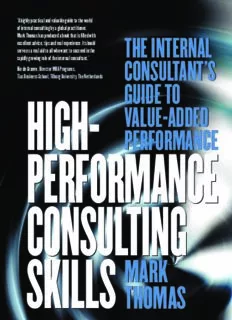Table Of Content‘A highly practical and valuable guide to the world
of internal consulting by a global practitioner.
Mark Thomas has produced a book that is filled with
TTHHEE IINNTTEERRNNAALL
excellent advice, tips and real experience. It should
serve as a real aid to all who want to succeed in the
rapidly growing role of the internal consultant.’
CCOONNSSUULLTTAANNTT’’SS
Bie de Graeve, Director MBA Programs,
Tias Business School, Tilburg University, The Netherlands
GGUUIIDDEE TTOO
HHIIGGHH--
VVAALLUUEE--AADDDDEEDD
PPEERRFFOORRMMAANNCCEE
PPEERRFFOORRMMAANNCCEE
CCOONNSSUULLTTIINNGG
SSKKIILLLLSS MMAARRKK
TTHHOOMMAASS
Inside front cover
HIGH PERFORMANCE
CONSULTING SKILLS
The internal consultant’s guide
to value-added performance
MARK A THOMAS
Published by Thorogood
10-12 Rivington Street
London EC2A 3DU
Telephone: 020 7749 4748
Fax: 020 7729 6110
Email: info@thorogood.ws
Web: www.thorogood.ws
Thorogood is a publishing division
of Acorn Magazines
© Mark Thomas 2003
All rights reserved. No part of this
publication may be reproduced, stored in a
retrieval system or transmitted in any form
or by any means, electronic, photocopying,
recording or otherwise, without the prior
permission of the publisher.
This book is sold subject to the condition
that it shall not, by way of trade or
otherwise, be lent, re-sold, hired out or
otherwise circulated without the publisher’s
prior consent in any form of binding or
cover other than in which it is published
and without a similar condition including
this condition being imposed upon the
subsequent purchaser.
No responsibility for loss occasioned to any
person acting or refraining from action as a
result of any material in this publication can
be accepted by the author or publisher. Special discounts for bulk
quantities of Thorogood books
A CIP catalogue record for this book is are available to corporations,
available from the British Library. institutions, associations and
other organizations. For more
HB: ISBN 1 85418 293 5 information contact Thorogood
PB: ISBN 1 85418 258 7 by telephone on 020 7749 4748, by
fax on 020 7729 6110, or e-mail us:
Cover and book designed by Driftdesign
info@thorogood.ws
Printed in India by Replika Press
Dedication
With love to Jan, Ben and Hannah
Special thanks
Dr Sam Elbeikfor his great help and co-operation in orig-
inating and developing the terms of reference templates and
assistance in the project management area.
Alf Chattelfor his continued support and permission in draft-
ing some of the process approaches and methodologies.
May you both continue to thrive and prosper.
Tracey Norburyof HSBC for lending some of her real life
observations.
A very special thanks to Matthias Behrensof Autodesk for
sharing his considerable experience.
Contents
Introduction 1
Symbols used in this book 4
ONE From managing change to
managing surprise? 5
Support functions under attack 10
The opportunity 11
What exactly is consultancy? 12
The difference between expert
and process consulting 13
What is the difference between the
internal and external consultant? 18
The characteristics of internal consultancy 24
Why use an internal consultant? 28
How to become an internal consultant 35
Time to convert and redirect 36
TWO The art of client management 39
Understanding the key stages of the internal
consulting process 40
Implementation 54
Belbin’s team roles – questionnaire 58
THREE Marketing internal consultancy 79
Getting in and contracting with your client 80
Developing your marketing strategy 82
Conducting a client demand analysis 84
What clients look for 87
Beginning to market yourself –
recognising your starting point 91
Marketing to senior management 92
How to sell to senior management 93
Some practical tips to improve your
marketing effort 96
Internal consultancy case study 98
FOUR Managing initial client meetings 105
The essential rules for managing
initial client meetings 107
Things to avoid at initial meetings 111
How to convey respect, openness and
understanding at an initial client meeting 112
Initial client meetings consultant’s template 113
Initial terms of reference 116
Writing client proposals 124
Managing initial meetings checklist 127
FIVE Understanding and defining
the client’s problem 131
Desk research 133
Interviewing clients 135
Managing the client interview 139
Group interviews 143
Types of interview questioning techniques 148
Providing non-verbal encouragement
during interviews 153
Using supportive statements 153
Counter-productive questions 158
Using questionnaires to gather information 160
Designing a questionnaire 160
Process mapping 176
Process analysis questions 183
Understanding and defining your client’s
problem – being client focused 185
SIX Managing change 189
Understandingorganizational change 190
Individual reactions to change 191
The change transition curve 196
Managing organizational change 201
Organizational change readiness assessment 205
Managing organizational change template 206
Change management template
– the critical success factors 208
Stakeholder Analysis 215
Managing organization change
– a checklist of key questions to address 217
The critical questions to ask in
change scenarios 223
SEVEN Presenting client feedback 225
Introduction to report writing 227
Different types of client report 230
Getting your report structure right 230
A typical report structure 231
Writing a client report 233
Reviewing reports 239
Making client presentations 240
Presenting client feedback –
being client focused 250
EIGHT Implementing, reviewing
and exiting projects 255
Project implementation 256
Project implementation – being client focused 259
Reviewing consultancy projects
– being client focused 261
Evaluating consultancy projects 262
Summary 264
NINE The internal consultant’s toolkit 265
The consultant’s toolkit 266
Organization capability: effectiveness
questionnaire • ‘7s’ organization audit 271
Internal consultant skills
– development needs checklist 279
Success factors in managing change 286
Change management action planning sheet 287
Description:The concept of the "internal consultant" is now gaining considerable ground as managers in support functions seek to redefine their role and effectiveness. The emphasis that it places on moving from a "colleague" to a "client" perspective within the business can bring major benefits to both adviser

